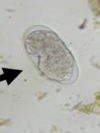Nematodes of Sheep Flashcards
what are nematodes of the abomasum
Teladorsagia circumcincta
Haemonchus contortus
Trichostrongylus axei
what are nematodes of small intestine
Trichostrongylus vitrinus
Trichostrongylus colubriformis
Nematodirus battus
Nematodirus filicolis
Cooperia spp
Strongyloides papillosus
Bunostomum trigonocephalum
what are nematodes of large intestine
Esophagostomum venulosum
Trichuris ovis
Chabertia ovina
what are the nematodes of lungs
Dictyocaulus filarial
Muellerius capillaris
Protostrongylus rufescens
what are the most significant nematodes of sheep
Teladorsagia circumcincta:
- Formerly Ostertagia circumcincta the ‘brown stomach worm’
Haemonchus contortus:
- The ‘barber’s pole worm’
- Different clinical picture
Trichostrongylus vitrinus:
- ‘Black scour worm’
- Northern Britain
Trichostrongylus colubriformis:
- ‘Black scour worm’
- Southern Britain
Nematodirus battus:
- Has different epidemiology to other nematodes
what is the direct lifecycle of nematodes
Strongylid eggs (70–150 μm) usually hatch within 1–2 days
After hatching, larvae feed on bacteria and undergo two moults within feces to then develop to ensheathed third-stage larvae (L3s) in the environment (i.e., feces or soil)
The sheath (which represents the cuticular layer shed in the transition from the L2 to L3 stage) protects the L3 stage from environmental conditions but prevents it from feeding
Infection of the host occurs by ingestion of L3s
The infective L3 migrate onto pasture
During its passage through the abomasum, the L3 stage lose their protective sheath then transition to the L4 and pre-adult stages

what is the PPP for most nematodes
16-21 days
what are the ideal temperature for environmental stages
>5C, ideal 18-26C
what are the ideal humidity for environmental stages
min 50-60%
ideally >80%
what is hypobiosis
arrested development
unfavourable conditions for L3
how long do the parasites survive in the host
only a few months
few adults survive winter
unless hypobiosis
how long do the parasites survive on pasture
L3 are most resistant
- Temperature extremes and desiccation, for many species infective L3 can survive up for 10-12 weeks
- Some species they can survive for up to 12 months and not killed by frosts (T. circ)
Moisture
Temperature
- Increased survival under temperate conditions vs tropical
- Teladorsagia circumcincta can survive freezing
- Haemonchus contortus cannot survive freezing
describe the environmental survival of the unembryonated egg of Haemonchus contortus
high susceptibility to cold and desiccation
high mortality <10C
describe the environmental survival of the embryonated egg of Haemonchus contortus
susceptible to cold and desiccation
low hatching in absence of moisture and/or at <10C
describe the environmental survival of the pre infective larvae of Haemonchus contortus
high susceptibility to cold and desiccaiton
describe the environmental survival of the infective larvae of Haemonchus contortus
optimum survival under warm and moist conditions
poor survival in dry climates (warm or cool) and sub freezing winter
describe the environmental survival of the unembryonated egg of Trichostrongylus colubriformis
intermediate susceptibility to cold and desiccation
high mortality at <5
describe the environmental survival of the embryonated egg of Trichostrongylus colubriformis
intermediate susceptibility to cold
low susceptbility to desiccation
describe the environmental survival of the pre infective larvae of Trichostrongylus colubriformis
susceptible to cold and dessication
high mortality at <5C
describe the environmental survival of the infective larvae of Trichostrongylus colubriformis
optimum survival under warm or cool moist conditions
poor survival over sub freezing winters
describe the environmental survival of the unembryonated egg of Teladorsagia circumcincta
low susceptibility to cold
intermed to desiccation
high egg viability at 0-10C
describe the environmental survival of the embryonated egg of Teladorsagia circumcincta
low susceptibility to cold and desiccation
hatching at <5C
describe the environmental survival of the pre infective larvae of Teladorsagia circumcincta
intermed susceptibility to cold
susceptible to desiccation
describe the environmental survival of the infective larvae of Teladorsagia circumcincta
optimum surivival under cool moist conditions and sub freezing winters
poor survival under warm, dry conditions









